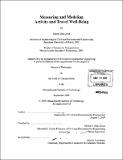Measuring and modeling activity and travel well-being
Author(s)
Abou Zeid, Maya, 1979-
DownloadFull printable version (21.65Mb)
Other Contributors
Massachusetts Institute of Technology. Dept. of Civil and Environmental Engineering.
Advisor
Moshe E. Ben-Akiva.
Terms of use
Metadata
Show full item recordAbstract
This thesis develops methods for the measurement of activity and travel well-being and models for linking well-being and behavior. The hypotheses underlying this research are that (1) activities are planned to maintain or enhance subjective well-being, and (2) given the activity choices, travel choices are likely to be motivated by a desire to maintain or enhance travel well-being. The aim is to enhance travel demand models, which overemphasize the generalized cost of travel, to better capture travel benefits, and to contribute more broadly to measurement and modeling efforts in the subjective wellbeing field. The thesis develops and tests a modeling framework that incorporates happiness measures as additional indicators of utility in discrete choice models based on random utility theory. The framework is applied to modeling both activity and travel choices and, in doing so, new well-being measurement methods are developed. Even though the applications focus on activities and travel, the framework is general and can be applied to modeling behavior in other domains. Activity well-being is investigated both empirically and theoretically. The empirical analysis consists of the development of models of activity participation and well-being using data from a web-based cross-sectional survey of a sample of commuters. The models reveal significant correlations between well-being and behavior: higher propensity of activity participation is associated with greater activity happiness and greater satisfaction with travel to the activity. (cont.) The theoretical analysis consists of the development of a framework and measures for the incorporation of well-being within activity-based models of travel demand. The analysis of travel well-being is done in the context of the commute to work. First, using the web-based cross-sectional survey, we develop a structural equations model to model the causes and correlates of commute satisfaction. Second, we study travel wellbeing in a dynamic context. We postulate that due to the routine nature of commuting, people are unlikely to fully think about their travel happiness unless they need to reconsider their decisions. We conduct experiments in Switzerland and at MIT requiring habitual car drivers to commute temporarily by public transportation and measure their travel happiness and mode choice pre- and post-treatment. We find that the routine (pretreatment) and non-routine (post-treatment) measures of travel happiness are significantly different, as postulated. We then use the data from these experiments to estimate the proposed modeling framework, whereby the car and public transportation happiness measures are used as indicators of utility. We find that the combined choice-happiness model results in more efficient parameter estimates than a choice model alone, thus demonstrating the benefits of the extended framework that includes happiness.
Description
Thesis (Ph. D.)--Massachusetts Institute of Technology, Dept. of Civil and Environmental Engineering, 2009. Cataloged from PDF version of thesis. Includes bibliographical references (p. 227-245).
Date issued
2009Department
Massachusetts Institute of Technology. Department of Civil and Environmental EngineeringPublisher
Massachusetts Institute of Technology
Keywords
Civil and Environmental Engineering.